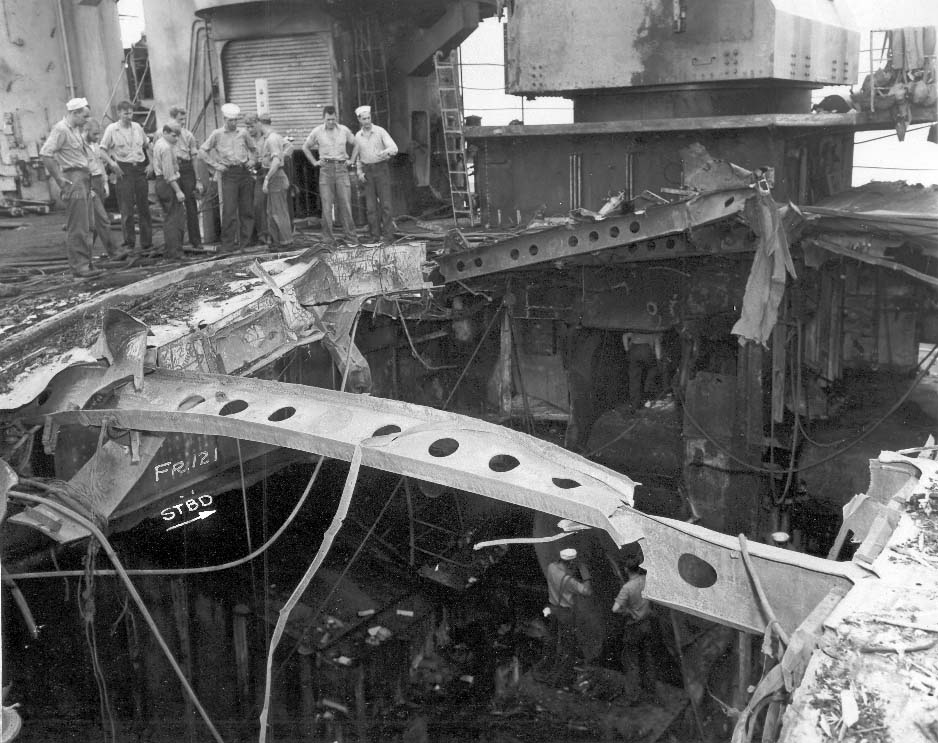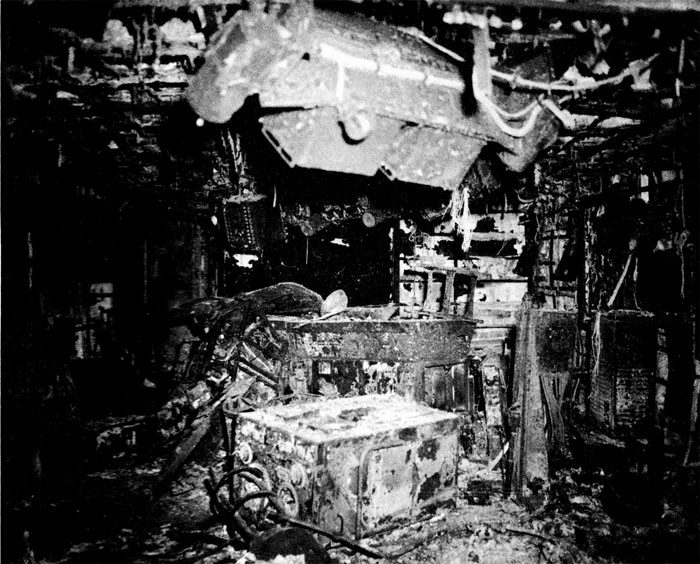Some Points From The USS Franklin CV-13 War Damage Report

I was rummaging through the USS Franklin CV-13 War Damage Report today and noticed a few things. (The numbers before each paragraph below denote the section and number of the paragraph. Direct quotes are italicized.) The report was probably written in late 1945 or in 1946.
Structural Damage
4-24 In the action of 19 March the detonation of the two enemy bombs plus the subsequent explosions of the ship‘s aircraft ammunition caused very heavy damage to structure above the hangar deck, moderate damage to the hangar deck itself and only negligible damage to spaces below the hangar deck…It is important in analyzing the structural damage to properly emphasize its relation to the survival of the ship. The damage, although impressive to the average observer, and certainly long and expensive to repair, did not appreciably impair the strength of the hull girder. Since the main deck (hangar deck) is the strength deck on this class of carrier, damage, however severe, to structure above this deck, will not compromise the strength of the hull.
My thought: The Bureau of Ships (BuShips) designed one heckuva fighting ship. It’s important to remember that no Essex-class carrier was sunk during any war in which ships of that class fought.
Fires and Firefighting
4-29 The action of 30 October was an excellent demonstration that a fire of tremendous proportions and intensity in the hangar and on the flight deck can be controlled and extinguished when firefighting facilities remain operable and are utilized properly.
4-30, The significant difference between the circumstances on 19 March and those of 30 October was in the amount of heavy ammunition loaded on the planes. In the earlier action only small caliber ammunition was involved; in the later action the flight and hangar decks were veritable arsenals. It is believed that, except for the ammunition involved, the fire of 19 March could have been brought under control and extinguished promptly as it was, however, hangar sprinklers and water curtains were demolished before they had an opportunity to produce an appreciable effect on the fire.

Fighting Gasoline Fires
4-37 The report states that when ten or more planes contribute gasoline to a fire, water alone cannot put out the fire. No matter how much water is sprayed on the fire from hoses or sprinklers, the fire will continue until it burns itself out. Water CAN reduce the fire’s intensity and reduce its spread.
Damage Control Notes
In this section, the format is to state a fact (see “h.” below) and follow it with a recommendation. Last will come a “Bureau Comment.” That comment is from the U.S. Navy Bureau of Ships.
“h. Armed machine guns on Hangar Deck created a considerable hazard in Hangar Spaces.
RECOMMENDATION: When possible that ammunition be taken out of planes at the end of strikes. In this connection it is further recommended that no bombs be stowed on Hangar Deck except immediately before loading on planes. If there had been bombs in planes on Franklin’s Hangar Deck without a doubt the ship would have been lost.”
BUREAU COMMENT: The exploding of small caliber ammunition presents but little actual hazard to personnel and is not particularly destructive to material.”
My thought: Two days ago, I listened to an audio recording of Radioman George Black’s oral history. He and 12 others escaped to the hangar deck after several hours of being trapped below. Fires still raged, destroyed aircraft, and dead bodies littered the deck, which had huge holes from explosions in it. He specifically mentioned the danger of ammunition from machine guns shooting off over their heads as they crawled from the port side to the starboard side of the hangar. There is no way to know if anyone was killed by exploding ammunition. The author of the Bureau Comment was obviously not there at the time, nor did he interview George Black.

Conclusion
In Section V-Conclusion, the following appears in the report’s final paragraph:
5-2. It now appears doubtful that the Japanese Kamikaze type of attack will again become a major factor in naval warfare but is rather a forerunner of the development and application of pilotless aircraft and guided missiles. Viewed in this respect, it is apparent that much additional information of possible future significance can be obtained by a careful study of the wealth of war damage experience resulting from Kamikaze attacks.
My thought: Whoever wrote that was prescient. The next war will probably be fought with drones and ship-killer missiles. I hope Damage Control is equally advanced.
Did you arrive here via a search engine? I am the author of the forthcoming book Heroes By The Hundreds: The Story of the USS Franklin (CV-13). In addition to writing about the bravery of the crews that saved her, I will discuss the lessons we can learn in leadership and decision-making and the changes the US Navy made because of those lessons.
Feel free to follow me on Facebook. There, I am M. Glenn Ross, Author. I also write a monthly newsletter, Glenn’s Action Report, about subjects I find interesting in my research. You can sign up for it below. Feel free to leave a comment or ask a question. Thanks for reading.
-Glenn